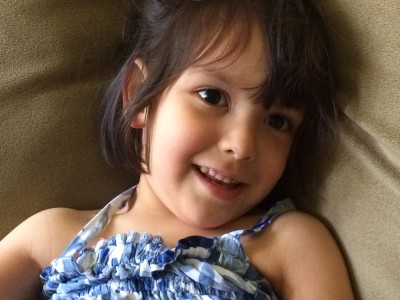This device lets my child speak with her eyes
by Beth
Bernhard Walke’s guest post earlier this month mentioned that their daughter Elena receives assistive technology services at Easter Seals DuPage & the Fox Valley Region and is learning to use a device I hadn’t heard of before. He’s back again this week to explain how Elena uses her beautiful eyes to communicate with the help of a Tobii Dynavox Communicator.
by Bernhard Walke
One compliment our daughter Elena receives most often is about her deep caramel colored eyes. My mother-in-law calls them “ojitos peruanos” or Peruvian eyes. Elena inherited them from her mother and her grandfather – my wife Rosa and my father-in-law.
To me, Elena’s eyes are bright, expressive, complex, and mysterious. My daughter’s eyes are a passageway to her mind. She sees them as more than aesthetic — they are the tools she uses to communicate.
Elena is nonverbal, so she uses her eyes to “point” to objects to indicate her choices. Does she want milk or juice to drink? Would she prefer to wear a blue dress or a purple dress to school? Additionally, looking up is an affirmative response and looking to the side or down is a negative. Movements such as this get us through the mundane day-to-day life, but Elena is 4 years old now and will be starting kindergarten next year. Her communication needs will be more complex.
In preparation for starting school next year, she has been working with a Tobii Eye Gaze computer, which is essentially a computer that tracks her eye movement. As a result, she is able to say things such as, “I have a question,” “That’s silly,” or “Something hurts.” She also works on identifying colors, zoo animals, and how to spell her name.
Considering that Elena does not have the oral muscle control to form words at this point, the possibilities are very exciting for us as parents. Elena realized the power of her words when she brought her Tobii to school for speech therapy and kept selecting the “Something hurts” icon. Her teachers and aids asked her questions and Elena responded, “I feel sick.”
“Do you think you need to go home?” inquired her teachers.
“Yes,” Elena responded.
Her grandparents were called to pick her up and Elena was infuriated. She loves school and didn’t want to leave her classmates. Elena turned out to be fine, and we laugh about the situation now, but we realize that this might have been one of the first times in her life that she realized that her voice was heard and what she said mattered.
When I explain what the Tobii allows Elena to say just based on the recognition of her eye movement, people are amazed with its capabilities and the fortune of living in a time when such technology is available. However, the device does come with challenges. Like myself, Elena is a raging extrovert and loves to be in the middle of the action. The Tobii, although it gives her a voice, creates a physical barrier between her and her audience. Just like her dad, she would much rather be face to face than face to screen.
The Tobii has some of the same shortcomings that other computer devices have: battery life, weight, lack of user friendliness, the time it takes to boot up, and so on. But despite all of its shortcomings, technology is an incredible tool for my daughter. This was demonstrated over the summer when her speech pathologist tracked me down at her extended school year program. She wanted to show me how Elena was using a Tobii to spell on a computer. Elena was learning to spell her name. “EEEEELLLLLLEEEENNNNNAAAAAA” was printed on a piece of paper.
The speech therapist mentioned something that we seldom hear, and her words confirmed what I’ve known for years. “Playing with letters like this is developmentally appropriate for her age.”








December 29th, 2017 at 1:32 am
This is really very good and also beneficial for the person.
September 6th, 2016 at 11:47 am
@Blaine,
I’m not sure about that. The reason my daughter uses this device is because she does not have purposeful use of her hands. Perhaps the best place to start would be a Speech Pathologist.
Best,
Bernhard
August 17th, 2016 at 11:47 pm
Our son, Andrew is 22 and is non-verbal He has used an iPad before, but we lost his program on it.
Please let us know if this could be be of use to him.
January 7th, 2016 at 11:01 am
Pam,
I’d love to talk with you more about this communication device. It’s certainly not perfect (it’s actually in the shop right now for repairs), but it’s a great avenue for communication. I’ll check in with you on email.
Bernhard
October 27th, 2015 at 7:44 am
What a wonderful story. Thanks for sharing.